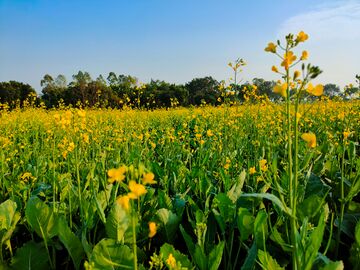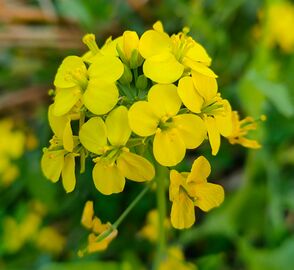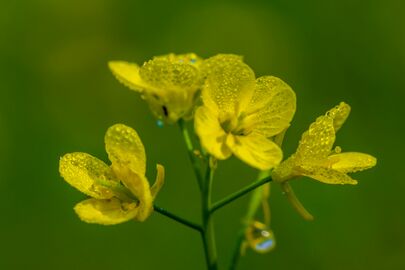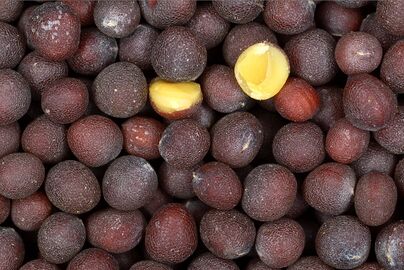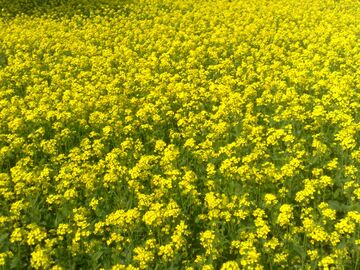خردل
| خردل | |
|---|---|

| |
| خردل بري (Brassica campestris) | |
| التصنيف العلمي | |
| مملكة: | |
| Division: | مستورات البذور Flowering plant
|
| Class: | ثنائيات الفلقة Dicotyledon
|
| Order: | |
| Family: | |
| فصائل | |
|
See text. | |
خردل (Mustard) هي بذور وزيت . مدرة للبول وهاضمة وتنشط التمثيل الغذائي بالجسم . الخرادل هى عدة أنواع نباتية (لها علاقة بالشلجم) تتبع الجنس Brassica
خردل أو قرلة وهو نبات عشبي يعرف منه نوعان:
التاريخ

Although some varieties of mustard plants were well-established crops in Hellenistic and Roman times, Zohary and Hopf note, "There are almost no archeological records available for any of these crops." Wild forms of mustard and its relatives, the radish and turnip, can be found over West Asia and Europe, suggesting their domestication took place somewhere in that area. However, Zohary and Hopf conclude: "Suggestions as to the origins of these plants are necessarily based on linguistic considerations."[1] The Encyclopædia Britannica states that mustard was grown by the Indus Civilization of 2500–1700 BC.[2] According to the Saskatchewan Mustard Development Commission, "Some of the earliest known documentation of mustard's use dates back to Sumerian and Sanskrit texts from 3000 BC".[3]
A wide-ranging genetic study of B. rapa announced in 2021 concluded that the species may have been domesticated as long as 6,000 years ago in Central Asia, and that turnips or oilseeds may have been the first product. The results also suggested that a taxonomic re-evaluation of the species might be needed.[4]
الأنواع
- خردل أبيض: بذوره مستديرة سفراء من الخارج ببضاء من الداخل ، تحتوي مادة مخاطية ، وبروتينات ، وزيت ، وجلوكوسيد يسمى "سينالبين" يتحلل ويعطي مركبا كبريتي غير سام. يستعمل في الطب وفي الطعام ضمن البهارات ، ويستعمل الزيت المستخرج مه كملطف للإلتهابات.
- خردل أسود: وهو أصغر من الأبيض ، زيته معروف ويسمى "سيننجرين" يحتوي على الكبريت ، وهو سبب الرائحة العطرية والطعم والحرافة ، وهو قوي جدا ، ولمسه فيه خطورة ، يلدغ الجلد ، ويصيب الأنف والعين بالأذى. يستخدم في الطب مخففا لتلطيف الإلتهابت وعلاج حب الشباب.
يستفاد طبيا من الخردل بإستخدام البذور وساء للخردل الأبيض أو الأسود وله إستعمالات مهمة منها: علاج حالات الصداع العصبي وآلام المعدة وإحتقانات الرئة وإلتهبات الحنجرة ويستعمل مسحوقه في عمل كريمات حيث يفيد في علاج تشقق الجلد وجفاف البشرة. ويمكن الإستفادة من الخردل بطريقة طبيعية وبسيطة بإستعماله كمسحوق أو معجون وإضافته للطعام ولكن بكميات غير كبيرة حيث انه يؤثر لدى المصابين بإرتفاع ضغط الدم وأمراض الكبد.
معرض صور
Bangladeshi mustard plants
انظر أيضاً
المراجع
- ^ Zohary, Daniel; Hopf, Maria; Weiss, Ehud (2012). Domestication of Plants in the Old World: The Origin and Spread of Domesticated Plants in Southwest Asia, Europe, and the Mediterranean Basin (Fourth ed.). Oxford: University Press. p. 139.
- ^ "Indus civilization | History, Location, Map, Artifacts, Language, & Facts | Britannica". www.britannica.com (in الإنجليزية). 2024-02-23. Retrieved 2024-03-01.
- ^ "What is Mustard?". Saskatchewan Mustard Development Commission. Mustard Consumer Website. SMDC 2011. Web. 16 March 2016 <"The Mustard Site | What is Mustard?". Archived from the original on 2016-03-25. Retrieved 2016-03-16.>.
- ^ Alex C McAlvay, Aaron P Ragsdale, Makenzie E Mabry, Xinshuai Qi, Kevin A Bird, Pablo Velasco, Hong An, J Chris Pires, Eve Emshwiller, Brassica rapa Domestication: Untangling Wild and Feral Forms and Convergence of Crop Morphotypes, Molecular Biology and Evolution, msab108, https://doi.org/10.1093/molbev/msab108, 30 April 2021.
وصلات خارجية
 وسائط متعلقة بـخردل من مشاع المعرفة.
وسائط متعلقة بـخردل من مشاع المعرفة.
